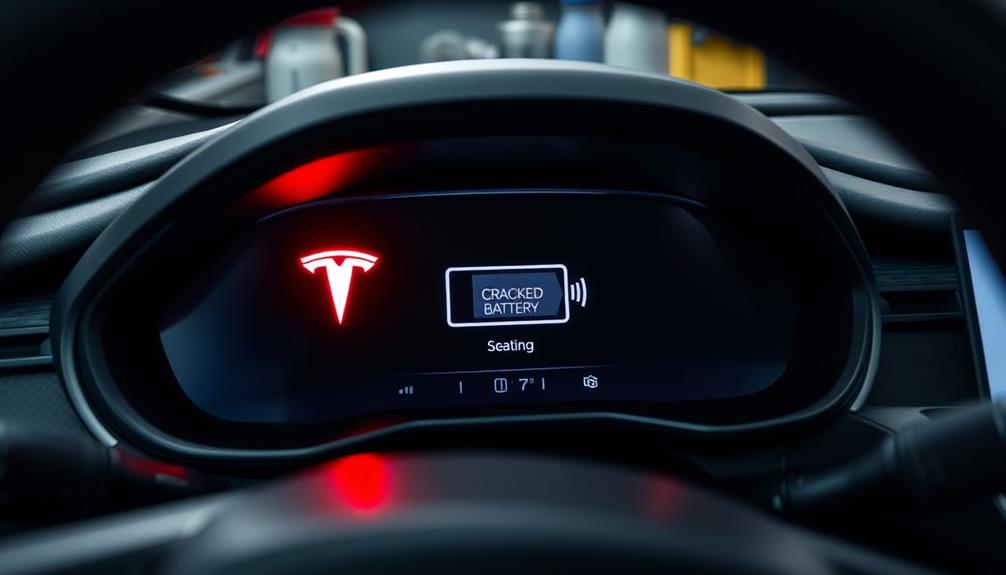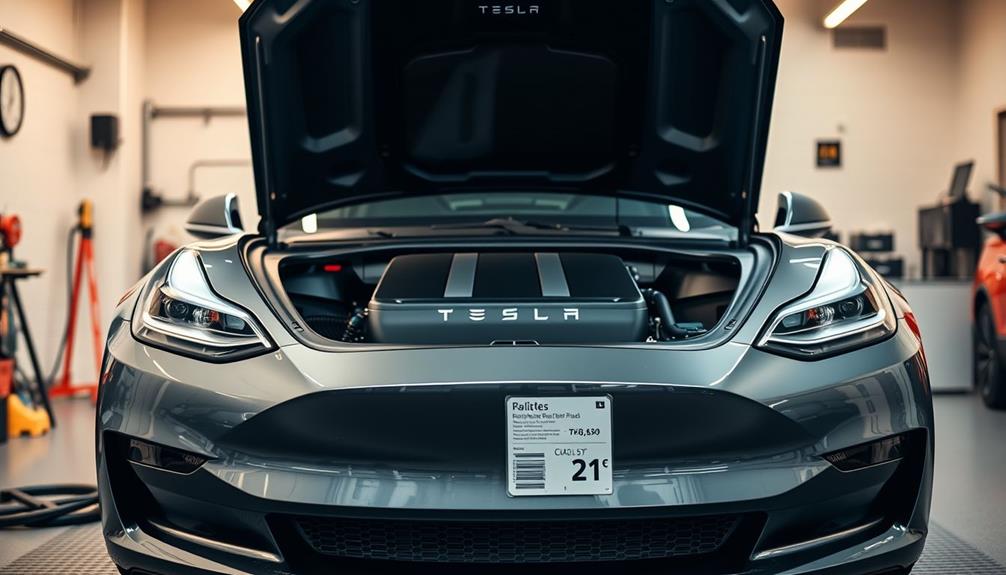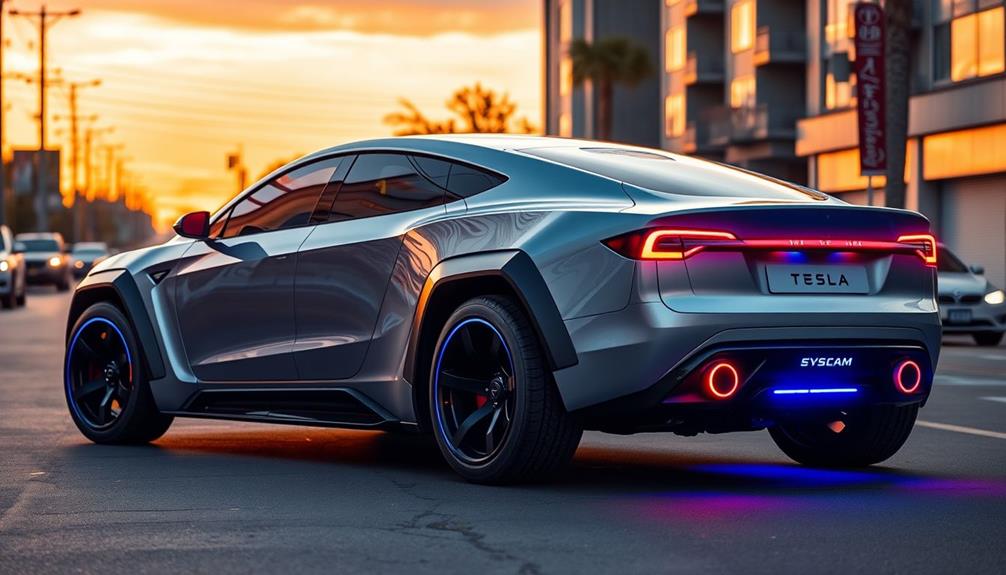Tesla battery replacement costs can vary widely by model. For example, replacing a Model S battery may set you back between $12,000 to $15,500, while the Model 3 might run you up to $28,000 for a total replacement. The Model X generally exceeds $13,900 in total costs, and Model Y replacements range from $10,500 to $11,400. Factors like labor, parts, and condition play a role in the final cost. It's crucial to assess your options carefully. Stick around to uncover tips on extending your battery's life and details on warranties that could save you money.
Key Takeaways
- Replacement costs for Tesla batteries vary by model, ranging from $10,500 for Model Y to $28,000 for Model 3.
- Model S battery replacement costs range from $12,000 to $15,500, with additional parts and labor fees.
- Model X battery replacements start at $10,600, while total costs exceed $13,900 based on repairs needed.
- Warranty coverage includes an 8-year or 100,000-mile guarantee against significant capacity loss for all models.
- Third-party repair options may offer savings but could risk warranty coverage and service quality.
Tesla Battery Replacement Costs by Model

When considering a Tesla battery replacement, the costs can vary widely depending on the model you own.
For the Tesla Model S, you're looking at battery replacement costs between $12,000 and $15,500. Additional parts can range from $20 to $200, and labor costs might set you back up to $2,600.
If you drive a Model X, expect to spend over $13,900, with uncomplicated repairs starting around $10,600.
For the Model 3, a remanufactured battery typically costs about $13,500, but total replacement expenses can soar to $20,000 or even $28,000 based on specific requirements.
If you have a Model Y, the estimated cost for a new battery pack falls between $10,500 and $11,400, with labor charges averaging around $500 for a typical three-hour job.
Signs Your Battery Needs Replacement

Noticing a sudden drop in your Tesla's driving range can be alarming, especially if it exceeds 20%. This significant change is one of the first signs that your battery may need replacement.
If you find that your battery capacity has degraded beyond 30%, it might qualify for replacement under warranty terms, offering you some peace of mind.
Another vital indicator is the battery's ability to hold a charge. If it fails to maintain a full charge, this could signal serious battery issues that require immediate attention.
Pay close attention to any notifications from Tesla regarding battery performance; these alerts are designed to keep you informed and should never be ignored.
Additionally, if you frequently experience a decrease in your driving range or feel that your Tesla isn't performing as it used to, it's time to assess your battery's health.
Being proactive about these signs can save you from more extensive issues down the road.
Warranty Coverage for Battery Replacement

Tesla offers robust warranty coverage for battery replacement, providing peace of mind for owners. With an 8-year or 100,000-mile warranty—whichever comes first—Tesla batteries are protected against defects and significant capacity loss. For pre-2020 Model S and Model X vehicles, the warranty is even more generous, featuring unlimited mileage for 8 years on most battery packs.
If your battery's capacity drops over 30% during the warranty period, you're covered for battery replacement. However, keep in mind that warranty terms can be voided if your vehicle receives improper service. This highlights the importance of certified maintenance to preserve your warranty coverage.
If you decide to sell your Tesla, the remaining warranty coverage transfers to the new owner, ensuring continued protection for the original battery warranty.
Here's a quick overview of Tesla's battery warranty coverage:
| Vehicle Model | Warranty Period | Coverage Details |
|---|---|---|
| Model S & X (Pre-2020) | 8 years (unlimited mileage) | Specific battery packs may vary |
| All Models | 8 years or 100,000 miles | Covers significant capacity loss |
| New Owners | Remaining warranty | Transfers with vehicle sale |
Replacement Options and Services

If you find yourself needing a battery replacement for your Tesla, you have several options to contemplate.
You can opt for Tesla service centers, which offer expertise tailored to your Model S or Model X but often come with higher Tesla battery replacement costs. Scheduling your battery service through the Tesla app can streamline the process, making it convenient for Tesla owners.
Alternatively, you might consider third-party repair shops. These facilities can provide cost savings for Tesla battery replacements, but they may lack the specialized knowledge vital for effective repairs. This could impact the overall quality of service and potentially lead to battery degradation over time.
For the more technically inclined, a DIY battery replacement is another option. However, this route requires significant technical skills and understanding to guarantee safety and effectiveness.
Keep in mind the warranty implications when choosing your replacement method; batteries replaced at Tesla service centers often maintain manufacturer warranties, while third-party replacements may affect future claims and coverage.
Ultimately, weigh your options carefully to find the best fit for your needs and budget.
Tips to Extend Battery Life

To maximize the lifespan of your electric vehicle's battery, it's essential to adopt a few smart practices. Start by charging at home whenever possible. This way, you can avoid the frequent use of DC Fast Charging, which can accelerate the degradation of your Tesla battery and reduce its overall battery capacity.
Another important tip is to avoid fully discharging your battery. Discharging at a typical rate of about 1% per day is ideal for maintaining battery health over time.
Additionally, try to drive on flat routes instead of inclines; this reduces strain on your battery and enhances energy efficiency during travel.
Storing your Tesla in a garage is also beneficial, as it protects your vehicle from extreme temperatures that can negatively impact battery lifespan and performance.
Finally, consider reducing cargo weight in your Tesla. A lighter load improves energy efficiency, which can help extend the lifespan of your batteries.
Frequently Asked Questions
Will Tesla Replace Your Battery for Free?
Yes, Tesla will replace your battery for free if it's under warranty and the capacity drops below 70%. Just guarantee you maintain the vehicle properly, as improper servicing can void the warranty.
How Much Is a Model Y Battery Replacement?
Ever wonder what it costs to replace a Model Y battery? You're looking at around $10,500 to $11,400 for the new pack, plus approximately $500 for labor, bringing the total to about $11,000 to $13,000.
How Much Does a Tesla Battery Charge Cost?
Charging your Tesla typically costs between $0.13 to $0.20 per kWh, depending on your local rates. For a full charge, expect to pay around $10 to $20, depending on your model and charging method. When comparing the cost of charging a Tesla to the price of filling up a gas-powered car, the savings can be quite significant over time. Additionally, some Tesla owners are able to take advantage of off-peak charging rates or other discounted programs, further reducing their Tesla charging cost. Overall, the cost of charging a Tesla is often much lower than the cost of fueling a traditional vehicle.
How Many Years Does a Tesla Battery Last?
Ever wondered how long your Tesla battery might last? It typically lasts between 10 to 20 years, depending on your driving habits and maintenance practices. Regular check-ups can help maximize its longevity and performance.
Conclusion
To sum up, understanding Tesla battery replacement costs can save you from unexpected expenses. Did you know that the average cost of replacing a Tesla battery can range from $5,000 to $7,000? By recognizing the signs that your battery needs replacement and knowing your warranty coverage, you'll be better prepared. Plus, following a few simple tips can help extend your battery life, keeping your Tesla on the road longer and saving you money in the long run.









